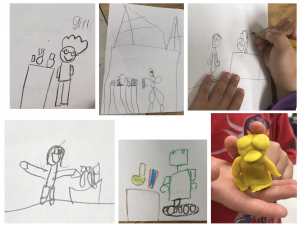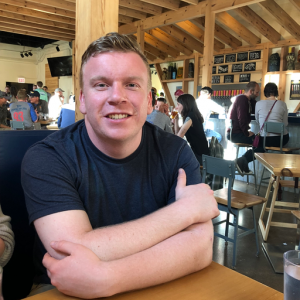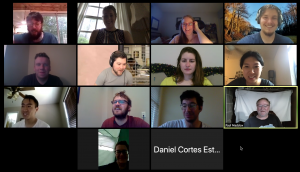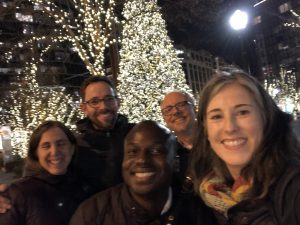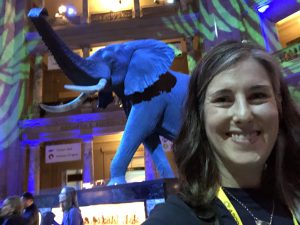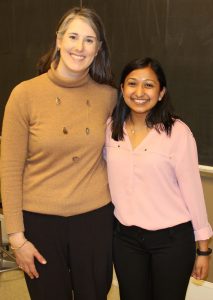Katie and Michael found that the negative regulators of contractility Katie characterized in the stable syncytial germline are also enriched on the dynamic cytokinetic ring. In this paper, they report how this kinase-containing heterodimeric complex is recruited to the cytokinetic ring downstream of the RhoA effector anillin. The dimer (GCK-1/CCM-3) promotes levels of the RhoA GAP RGA-3/4 in the cytokinetic ring, limiting RhoA activity and contractility. Interestingly, GCK-1/CCM-3 also reduce RhoA levels in cortical patches during prophase pulsed contractility, but do not change the period of RhoA pulsing. Check it out!
Author Archives: Amy Maddox
Jack Linehan joins the lab – and is funded!
Jack Linehan is starting his second year at UNC, and is pursuing his PhD in the aMDX lab after rotating with Amy and with Paul. He decided to join the QBio program in Biology! And he won a spot on the MiBio NIH T32! Jack comes from a physics background, and also worked as a tech in a zebrafish cell migration lab. He has thrown himself into several projects bringing his insights and sponging up new biology and physics.
MDX lab meeting goes virtual
Post-doc Daniel Cortes has a paper accepted at Biophysical Journal
Daniel comprehensively compared the effects of coarse graining vs discretization of motor domains in non-muscle myosin II ensembles. He also compared the effect of bond type – catch-, slip- or catch-slip-bonding. Working with Cytosim particle-based modeling in collaboration with Cytosim creator Francois Nedelec, Daniel compared motor behavior on various networks: immobilized fibers, 2D patches, linearized cables, and rings. Check it out!
UNC teaching goes virtual
Amy’s undergraduate courses were hurriedly transformed to virtual over spring break. Our “core” developmental biology survey had only begun before shut-down, but we spent a lot of time together on zoom and these honors students’ motivation showed as they rose to the occasion of virtual learning. Some even peeked out on camera on our last meeting! Bravo, all.
Amy’s honors thesis course culminated with a mostly-asynchronous symposium (no cheese cubes – sad!). The 40 amazing students, their PIs, the TAs, and all the faculty that helped judge talks and theses truly went above the call of duty at this very trying time and helped to bring these honors theses to fruition. Bravo, all!

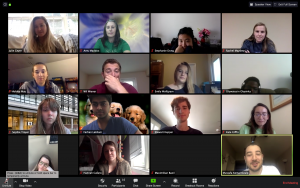
Amy presented two talks at ASCB
Amy was honored to present work entitled “Space-time-frequency Shape Mapping Reveals Harmonics in Contractile Oscillations during Cytokinesis” from co-authors Michael Werner, Dylan Ray, Coleman Breen, Adam Sattler, Paul Maddox, Florian Jug, and Sebastian Fürthauer. The progress of this work has also benefited from consultation by Hau-Tieng Wu and Ingrid Daubechies, our neighbors at Duke. Their abstract was selected for a Saturday Special-interest Subgroup on Machine Intelligence and Statistics in Cell Biology co-organized by Kwonmoo Lee (Worcester Polytechnic Institute), Jean-Chrisophe Olivo-Marin (Institut Pasteur, France), and Assaf Zaritsky (Ben-Gurion University of the Negev). The work was also invited for a Scientific Workshop “From Single Molecules to Understanding of the Cellular Processes using Biophysical Methods” hosted by Chip Asbury (University of Washington), Ibrahim Cisse (Massachusetts Institute of Technology), and Martin Loose (IST Austria). Workshop speakers later bonded over an outstanding dinner.
Post-doc Daniel Cortes chosen for ASCB mini-symposium three-peat
Daniel presented his work “Measured Contractile Ring Component Dynamics Inform Agent-based Models of Animal Cell Cytokinesis” in a talk for the Higher Order Cytoskeletal Structures minisymposium, co-chaired by Prachee Avasthi (University of Kansas Medical Center) and Jessica Feldman (Stanford University). His co-authors were D. Cortes, M. DiSalvo, N. Allbritton, F. Nedelec, P. Maddox, and A. S. Maddox. The talk was very well-received, and we’re all grateful for the opportunity!
former undergraduate Anusha Doshi accepted into UNC med school!
Undergrads wrap up the semester w talks and posters
Several undergraduates in the lab were carrying out research for course credit this past semester, and their projects culminated with oral presentations at the honors thesis symposium (Larry Yang not pictured here) or posters. They all did terrific work and presented it clearly and thoughtfully. The aMDX lab is grateful for their contributions!
counterclockwise from top left: Adhham Zaatri is proud of his poster; Arusha killed her talk at the Koeppe Biology Undergraduate Honors Symposium; Daisy Hensley and her very quantitative poster!
What does a scientist look like? A kid!
Amy enjoyed teaching 11 classrooms of kindergarteners and 2nd graders at a local elementary school, in partial fulfillment of the lab’s commitment to substantial outreach in conjunction with our NSF grant. She asked the kids:
what do scientists do? (lots of action words that happy kids act out!)
what does a scientist look like? (the kid in the mirror! – the kindergarteners drew their ideas)
what kinds of questions do scientists ask? (the Q words minus “why”)
what is a cell? (the building block of living things)
can you see a cell? (sure, but many can’t be resolved without a microscope!)
And then she walked the kids through these broad steps of animal development:
a very big cell
cleavages
rearrangements
animal growth
And the kids did the first 3 steps hands-on with playdough!
Take home messages:
teachers are HEROS!
kids are scientists!
